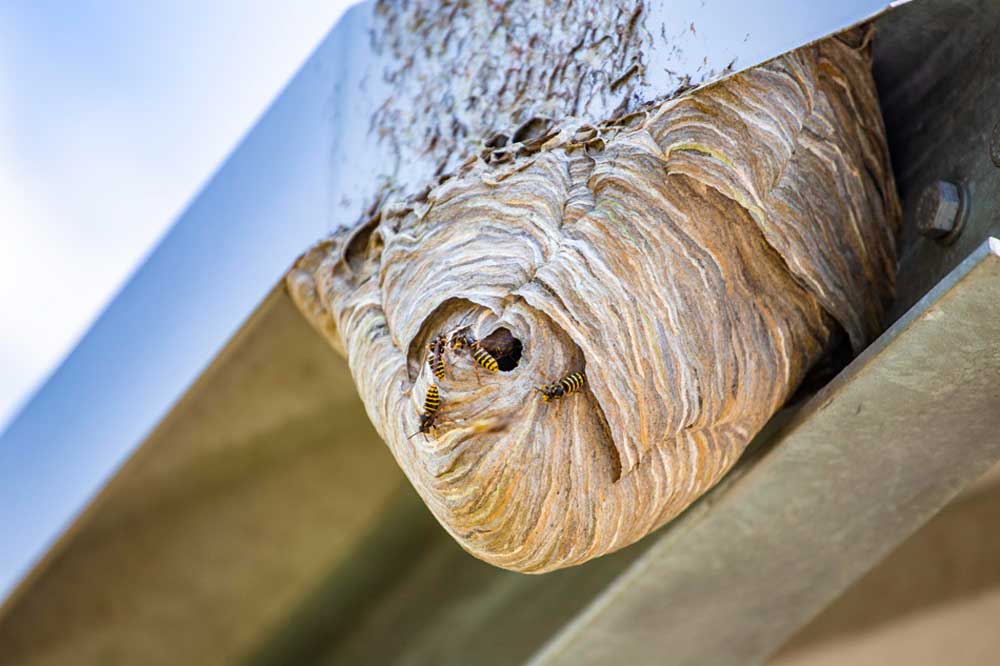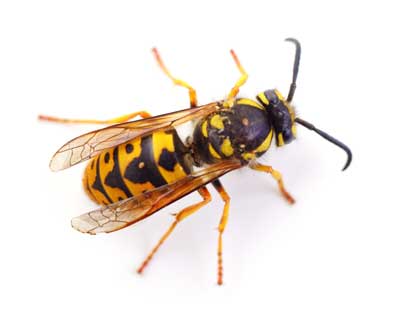Wasp Nest in Soffit: How to Detect and Prevent Risky Infestations
A wasp nest in soffit spaces can go unnoticed until the colony is well-established and causing problems. If you’ve seen wasps hovering near your roofline or slipping into small gaps under the eaves, there’s a strong chance they’re nesting in this hidden area. These hidden areas, out of sight and often undisturbed, offer wasps the ideal place to build and expand their colonies.
Whether you’re hearing buzzing from above or spotting increased activity near vent panels, it’s important to understand why soffits attract wasps, how to confirm a nest, and what steps to take next. Left alone, a small nest can quickly grow into a serious problem for your home and your safety.

Why Wasps Nest in Soffit Spaces and Why It Matters
Soffits are the flat panels that run beneath your roof’s overhang. They serve an important purpose, ventilating your attic and preventing moisture buildup, but their quiet, sheltered design also makes them a magnet for nesting wasps.
Wasps are drawn to soffits because they offer warmth, cover from wind and rain, and discreet entry points into roof voids. In early spring, queen wasps begin searching for protected areas to start building, and any small gap in your soffit vent or fascia board becomes a potential access point. Once inside, they can build undisturbed, and most homeowners won’t even realise a colony is growing until wasps start entering the loft or appearing indoors.
Older properties and homes with damaged or poorly sealed soffits are especially at risk. Once a colony is established, it can spread into adjoining attic insulation or wall cavities, increasing the challenge and danger of safe removal. In some cases, the problem may evolve into a full wasp nest in attic or behind wall panels, making professional intervention critical.
How to Spot a Wasp Nest in Soffit Areas
Because soffits are elevated and often out of direct view, nests in these locations can go unnoticed for weeks. However, certain signs can help you identify a potential problem early.
Start by observing wasp activity from outside your home. If you notice wasps flying in and out of the same spot near your roofline, especially around soffit vents or joints, it may indicate a hidden nest. Unlike random foraging behaviour, this direct flight path is a strong clue that a colony is active inside.
Buzzing sounds inside the house, particularly in ceiling corners or attic spaces, can also suggest wasps nesting close to the soffit area. You might also hear increased activity on warm afternoons, when wasps are most active.
Professional pest controllers often use tools like thermal imaging to detect the heat signature of a nest behind panels. In some cases, fibre optic cameras allow safe visual inspections through small gaps, minimising damage while confirming an infestation.
The Dangers of a Hidden Wasp Nest in Your Roofline
While it might seem like a minor nuisance at first, a wasp nest in soffit areas can quickly escalate into a real hazard.
As the colony grows, it can block soffit vents, reducing airflow into your attic and potentially causing heat or moisture issues. In more advanced cases, nests can spread into insulation and roof cavities, leading to costly structural or energy efficiency problems.
There’s also the risk of stings. Wasps are territorial and will aggressively defend their nest if disturbed. This becomes dangerous if they begin entering loft spaces or emerging inside your home through wall cavities, posing a risk to children, pets, or anyone with allergies.
Attempting to deal with soffit nests on your own, especially those located high up or hidden in enclosed spaces, can lead to serious injury. Without proper equipment or knowledge, you may unintentionally provoke the colony.
Preventing Wasps from Nesting in Your Soffits
Once a nest has been safely removed, prevention should be your next priority. Keeping wasps out of soffit spaces is a matter of sealing access points and maintaining your roofline.l
Begin with a full inspection of your soffit panels, fascia boards, and vent openings. Look for any cracks, lifted edges, or broken mesh screens that could serve as entry points. Use exterior-grade sealant to close small gaps and consider installing fine wire mesh (less than ¼ inch) over soffit vents to maintain airflow while keeping insects out.
Trimming back nearby trees or climbing plants can also help, as these often give wasps an easy path to your roof. In many cases, the activity may start from a nearby wasp nest in tree, eventually leading them to your soffits or roof tiles. Be especially vigilant in early spring when queens are actively searching for nesting sites. Regular visual checks from the ground can help you catch early signs before a full colony takes hold.
Professional pest control services may also offer deterrent treatments or inspection plans to keep your soffits and roofline protected year-round.
For homeowners avoiding chemicals, natural wasp removal methods, such as essential oil sprays or decoy nests, can provide additional layers of protection during peak activity season.
Stay One Step Ahead of Wasps in Your Soffits
A wasp nest in soffit panels is more than an inconvenience; it can impact your home’s ventilation, comfort, and safety. These elevated, hard-to-reach areas provide ideal shelter for nesting wasps and often go undetected until the colony is well established.
By knowing what signs to look for, taking early preventive steps, and responding quickly to suspected activity, you can avoid costly damage and reduce the risk of stings or infestation inside your home.
As with most infestations, early action during the wasp breeding season can significantly reduce the risk of nests forming in hidden roofline spaces.
Need Help with a Wasp Nest in Your Soffit?
A wasp nest in soffit spaces can grow quickly and quietly, posing risks to both your home and your safety. These hidden nests are often elevated, hard to access, and dangerous to remove without experience.
For fast, discreet, and professional wasp nest removal, call 087 254 2839 or book online today. Our expert team will safely eliminate the nest and help protect your roofline from future infestations.
